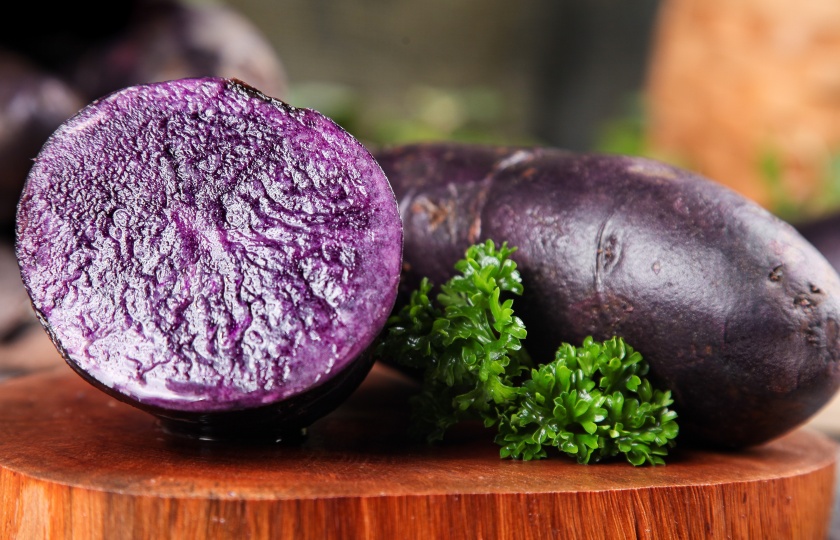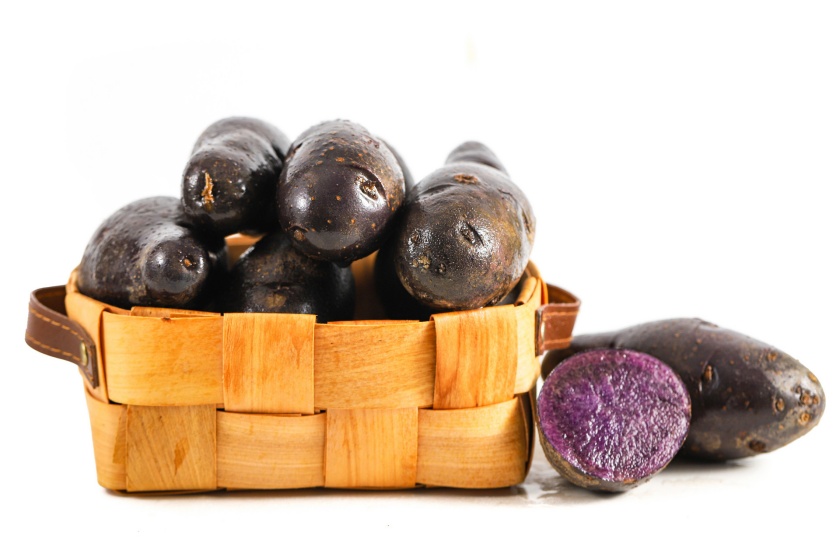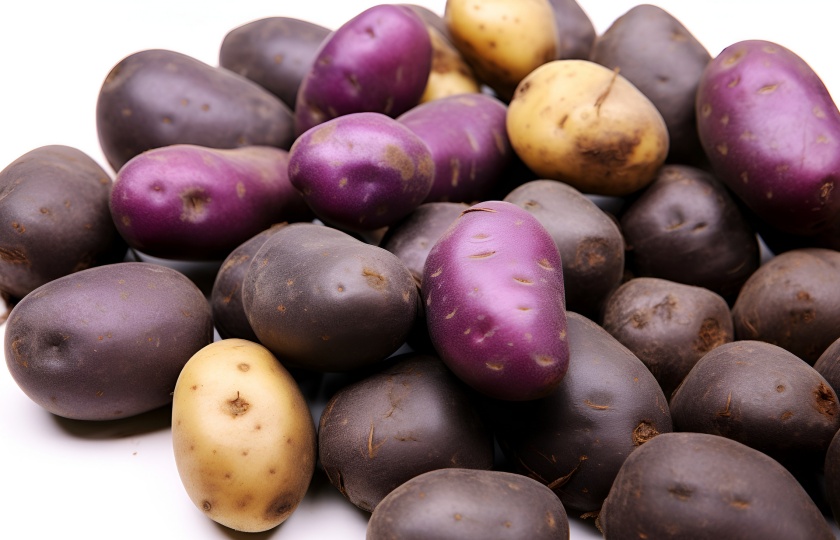Want to know the calorie content of a purple potato? Find out now!

Want to eat potatoes but worry about getting fat? Today, I will introduce the calorie content of purple potatoes and show you how many calories there are in a purple potato to facilitate weight control.
How many calories in a purple potato?
I specifically studied it. The calorie content of a purple potato is related to its size. Generally speaking, the calorie content of 100 grams of purple potatoes is about 82 - 100 kilocalories.
If it is a small purple potato, it may only be 100 - 150 grams, and the calorie content will be between 82 - 150 kilocalories. If it is a relatively large purple potato, with 200 - 300 grams, the calorie content is about 164 - 300 kilocalories. Moreover, the calories of purple potatoes mainly come from carbohydrates. They are rich in dietary fiber and are relatively slowly digested and absorbed, with a relatively strong sense of fullness. Therefore, during the weight loss period, eating an appropriate amount of purple potatoes does not need to worry too much about exceeding the calorie limit.
Is purple potato good for diet?
Purple potatoes are suitable for people who are losing weight to eat.
First of all, from the perspective of calories, the calorie content of purple potatoes is not high, about 80 - 100 kilocalories per 100 grams. And purple potatoes are rich in dietary fiber, which is a "little helper" for weight loss. After eating purple potatoes, it can effectively help enhance satiety and reduce the intake of other high-calorie foods.

In addition, the glycemic index of purple potatoes is lower than that of many staple foods. This means that after purple potatoes enter the body, blood sugar will not rise very high all at once, avoiding the conversion of excess blood sugar into fat and being stored up.
But it should also be noted that although purple potatoes are beneficial for weight loss, they cannot be eaten without restraint. If you eat too much and consume too much carbohydrate, there is still a risk of exceeding the calorie limit.
It is best to use purple potatoes as part of the staple food to replace rice, noodles and the like. In this way, while enjoying the delicious taste, it can also help us better control our weight.
What is the lowest calorie potato?
Strictly speaking, for different varieties of potatoes, the calorie difference between them is not particularly large. But relatively speaking, purple potatoes have a slightly lower calorie content, about 80 - 100 kilocalories per 100 grams.
Suitable for eating during weight loss. Not only is it low in calories, but it also contains rich dietary fiber, vitamins and minerals, which helps promote intestinal peristalsis and digestion, provides a sense of fullness. At the same time, the antioxidant component anthocyanin in purple potatoes helps enhance immunity and anti-aging.
Secondly, there is also a variety of small potatoes. They are small in size and have relatively less carbohydrate content. The calorie content may be slightly lower. But this difference is really very small.
Moreover, the calorie content of potatoes is also closely related to the cooking method. For example, fried potatoes will have a very high calorie content due to absorbing a large amount of oil. If potatoes are boiled or steamed, their original calorie content can be better retained, which is a relatively healthy way of eating.
Are purple potatoes healthier than regular potatoes?
First of all, in terms of nutritional components, purple potatoes contain a large amount of anthocyanin and have a very strong antioxidant effect. As I said before, anthocyanin can fight free radicals and is especially good for the skin. It can make our skin more shiny and delay aging. Although ordinary potatoes also have some nutritional components, the content of anthocyanin is relatively low.

In terms of dietary fiber, purple potatoes are also not inferior. It can promote intestinal peristalsis and help us digest and prevent constipation. However, the dietary fiber in purple potatoes may have some differences in structure and has a unique effect on our intestinal health.
Also, the content of minerals in purple potatoes is also relatively rich. For example, there is relatively more potassium. Potassium is very good for our heart health. It can regulate blood pressure and reduce the risk of cardiovascular diseases.
However, ordinary potatoes also have their advantages. For example, their starch content is relatively high and can quickly provide us with energy. Therefore, it cannot be simply said that purple potatoes are completely healthier than ordinary potatoes. They all have their own characteristics. We can choose to eat them according to our own needs.
Which kind of potato is the healthiest?
If you pay attention to the antioxidant function, then purple potatoes are a great choice. Because purple potatoes are rich in anthocyanin, which can remove free radicals, protect our body cells, and reduce the risk of aging and disease.
If you want to supplement vitamin C and potassium, ordinary yellow-skinned potatoes are good. Yellow-skinned potatoes have a relatively considerable content of vitamin C. Every 100 grams can provide a certain amount of vitamin C, which is helpful for enhancing immunity and promoting collagen synthesis. At the same time, the rich potassium element is very important for maintaining the normal function of the heart and muscles, and is very suitable for friends who need to supplement these nutrients.
From the perspective of controlling blood sugar, new potatoes (that is, tender potatoes that have just been harvested) may be better. The glycemic index of new potatoes is relatively low. After eating, the blood sugar rises relatively slowly, which is friendly to diabetic patients or people who want to control blood sugar.
In addition, small potatoes are also a good choice. They are small in size and have similar nutritional density as large potatoes. And because of their moderate size, they are easier to cook thoroughly and can better retain nutritional components. For example, roasted small potatoes have a crispy skin and a soft and glutinous interior, and are also very healthy.
However, no matter which kind of potato, the cooking method is also crucial. Steamed potatoes are definitely much healthier than fried potatoes. Fried potatoes will absorb a large amount of oil, and the calorie content will increase significantly. Moreover, some harmful substances may be produced during the frying process. Therefore, even if you choose the right variety of potatoes, you should also pay attention to the cooking method so that potatoes can be eaten healthily.
Which kind of potato has the lowest carbohydrate content?
In fact, the carbohydrate content of different varieties of potatoes is not particularly different.
Generally speaking, among common potato varieties, small potatoes may have a relatively lower carbohydrate content. However, this is also related to factors such as the size of the potato and the growing environment.
For example, 100 grams of ordinary large potatoes contain about 17-22 grams of carbohydrates. Small potatoes are smaller in size, so the overall carbohydrate content may be less, and 100 grams of small potatoes contain about 15-18 grams of carbohydrates.
There are also some colored potatoes, such as purple potatoes, whose carbohydrate content is similar to that of ordinary potatoes, and 100 grams is also around 17-20 grams.
But be careful, even with these subtle differences, potatoes themselves are still high-carbohydrate foods. If you are controlling your carbohydrate intake, you should still eat them in moderation and combine them with healthy cooking methods, such as boiling or steaming, so that you can better manage your carbohydrate intake.























